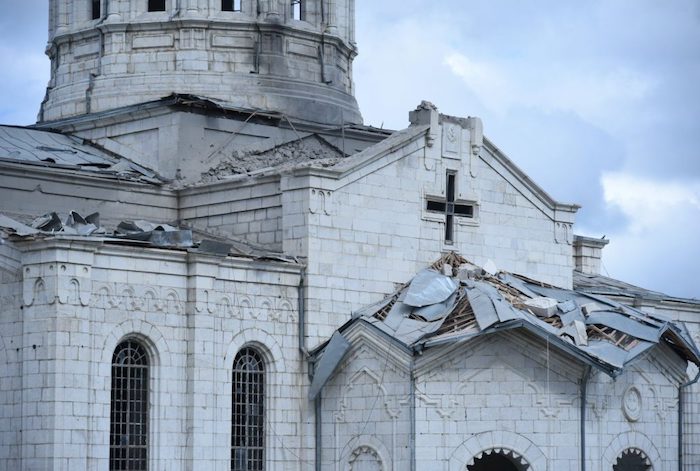NEW YORK — Less than a month after two missiles significantly damaged the Ghazanchetsots Cathedral in the Armenian town of Shusha last October, Hovik Hovsepyan and Mariam Sargsyan stood at the cathedral’s altar and became married amid the rubble.

“We realized that continuing our wedding plans would be our message to say that despite the bombings, our church would never lose its sanctity and value,” Sargsyan said, acknowledging they were worried they might get bombed while inside.
The couple told their story as part of the Ghazanchetsots Cathedral portion of a new, exclusively virtual exhibit from the Museum of the Bible titled, “Ancient Faith: The Churches of Nagorno-Karabakh,” that features seven Armenian Christian holy sites in the Nagorno-Karabakh region, historically know to Armenians as “Artsakh.”
It’s the first all-virtual exhibit created by the museum. Jeffrey Kloha, the chief curatorial officer, told The Tablet he hopes the exhibit sheds light on the value of these historic Christian sites and the danger they face.
“We decided to do a really important story and something that Americans probably don’t know about. In many ways, it’s a microcosm of issues throughout the region of these sites being at risk, these monuments being at risk, and people losing access to places where they’ve worshipped for a very long time,” Kloha said.
In fact, the exhibit was originally only supposed to have a few images before missiles hit the Ghazanchetsots Cathedral — also known as the Holy Savior Cathedral — and the military situation became uncertain. That’s when Kloha said planners transitioned to making it a much bigger project, not just with images of the sites but videos featuring personal stories from worshippers in the region.
“We hope that it has a broad impact to bring people’s awareness to this issue and these sites in particular,” Kloha said. “It’s one thing to see the beautiful monuments, but what we really wanted to convey is these are not just old piles of rubble and they’re not just of archeological interest or of historical interest of centuries past, but living, active places of worship for people who themselves have faced war.”
Last September a longstanding conflict between Armenia and Azerbaijan over the Nagorno-Karabakh region erupted. At the conclusion of six weeks of fighting the two sides lost more than a combined 5,000 troops. And Azerbaijan made territorial gains in the Nagorno-Karabakh region per a peace deal signed on Nov. 10 by Armenia, Azerbaijan, and Russia.
Nagorno-Karabakh is internationally recognized as Azerbaijani, though ethnic Armenians had run the region since 1994. Armenia is majority Christian while Azerbaijan is majority Muslim.
The missiles hit the Ghazanchetsots Cathedral on October 8, though neither side admitted fault. As of this May, the United Nations Educational, Scientific, and Cultural Organization was still seeking permission from Azerbaijan to visit the cathedral and other heritage sites in Nagorno-Karabakh on a preservation mission. Now months later, reports in recent weeks indicate that tensions are again rising between the two sides.
The other sites featured in the exhibit are:
Amaras: A monastery and the tomb of Saint Gregory’s grandson, Saint Grigoris
Tzitzernavank: An early Christian basilica
Handaberd Mother and Child: A “khachkar,” or cross-stone, an iconic art form and symbol of Armenian religion identity and craftsmanship
Dadivank: A religious landmark, and intact mosaic complex from the 13th century
Gandzasar: A 13th-century cathedral considered the crown jewel of Armenian architecture
Tzar: A school building constructed during the Soviet period from vandalized and recycled Armenian monuments during the Soviet period.
As part of the exhibit, each site has a photo gallery and video featuring a personal story from a local worshipper. Kloha said the videos are “very important to help people understand that these sites were preserved by people of faith, and in turn, these sites have inspired people and helped them persevere in the face of tremendous hardship.”
The video for Amaras, for example, features Father Geghard Hovhannisyan, the Abbot of the monastery, walking inside the monastery walls, telling its history, and personal importance.
“God has given each of us a mission during our lifetime in this world, a calling for each of us, on our own mission and path,” Father Hovhannisyan said. “I will fulfill mine here. My heart will forever be tied to Artsakh and Amaras.”
The virtual exhibit as a whole is a precursor to a larger in-person “Bible in Armenia” exhibit the museum is preparing for March of 2022. Kloha called it a “niche story” that’s “worth our attention. And noted the fact that not many Americans know the history of Armenian Christians, which was officially the first Christian nation in the 4th century.
“Part of our goal at the Museum of the Bible is to show the impact of the bible around the world,” Kloha told The Tablet. “Here’s a nation of people which has maintained its Christian identity and, in many ways, struggled because of it, and yet sustained that Christian identity for centuries.”
